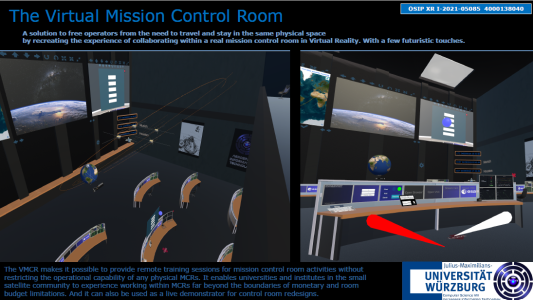The Virtual Mission Control Room (VMCR)

The Virtual Mission Control Room (VMCR) is an attempt to free operators from the need to travel
to and stay within the same physical Mission Control Room (MCR).
The main objective is to design and create a completely usable prototype, providing an adaptable
collaborative virtual environment suitable for operation and monitoring of small satellites as well as
operator training. The system is comprised of frontend and backend systems: The backend,
designed as an easily deployable microservice architecture, takes care of server-side aspects of
communication, data handling and storage, while the frontend provides the client-side
communication and VR user interface within a single executable.
The VMCR features VR scenes and assets to support mission operations and teaching: a fully
usable voice-loop-control panel for multi-channel voice-loop training based on Mumble/Murmur, a
native VR telecommand frontend for RODOS/Corfu-based systems, screen casting, avatars, chat
and tutorial scenes for new-to-VR operators. In addition, special assets, such as a floating globe
depicting satellite positions, demonstrate the capabilities of presenting data in VR. Further,
operators are able to adjust their active virtual environment according to their preferences. Side
meetings can take place in a range of virtual meeting rooms, facilitating both the structured
discussions of work group sessions the relaxed interactions akin to informal chats with colleagues
during breaks.
The system can be accessed from normal workplaces, which will permit to offer operator training
without impeding usage of the real mission control rooms. There are two main scenarios: If the
normal workplace computers are VR-capable a secure connection to the backend server will
suffice to use the VMCR from the normal office. In that case, only the frontend software and VR/XR
headsets need to be distributed to experience the VMCR. Alternatively, the user-part of the VMCR
and VPN software can be installed on a gaming-notebook and brought to users, tin combination
with the headset as temporary installment for training purposes.
The VMCR is intended to be provided as free and open source solution.
